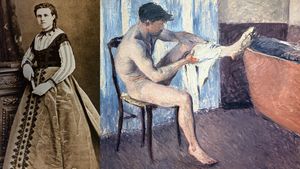At the beginning of my presentations on domestic violence, I usually pose this question first before even getting into the topic: "What does a victim look like?" No matter the venue or crowd, the responses are almost always the same -- "the victim is an adult woman, usually older and married" or "she has a couple of children." I am also told that this woman doesn't work, she is a stay-at-home mom, and when her husband comes home at the end of the day and dinner isn't ready, she gets beaten. For many victims this is far from the truth. The truth is victims come in all shapes and sizes, from all backgrounds and genders.
This misunderstanding is what leads millions of victims to stay silent and not seek help. I talk to many victims who are men, gay, straight, married, and unmarried. Sometimes they think they're not victims because they don't fit into this definition of domestic violence -- and that simply isn't true.
During one of my presentations at a local high school, I brought up the topic of violence against men and began the lecture I always give about how men can be victims too. I saw this young man in the front row who was looking at the ground. A tall, muscular football player, he had his jersey on for the game that night. He looked at the ground and mumbled something. I asked him to repeat what he said; he wouldn't look up, but he mumbled again. When I asked him a third time, he finally looked up at me and said, "If this were happening, no one would believe me." I can only imagine the courage it took for him to say this in front of his peers. Sadly, there are many who may never identify as a victim or seek services for fear that they will be mocked or made fun of. The conversation around social norms needs to happen so no one is afraid to access services that are readily available.
For so many years, domestic violence was seen as a women's issue. The work we are doing with prevention education is helping change this way of thinking, making programs and services more welcoming to people of all identities.
I once had a conversation with a young woman who shared that she too had experienced dating violence at a very young age. Her girlfriend was extremely jealous and possessive and controlled her every move. She said that when she wanted to make plans she would need to ask permission from her partner, and then check in throughout the time she was away from her. Although she experienced verbal abuse and ridicule from her partner, she too stated that she never would have identified herself as a victim of domestic violence, because she wasn't married and wasn't in a heterosexual relationship.
The reality is domestic violence happens to everyone; physical abuse from an intimate partner is experienced by one in three women and one in four men in the U.S. To make services accessible to everyone we need to make sure people know that anyone can be a victim. This message can be as important as details on the available resources themselves. Helping individuals understand that this is not just a women's issue opens the door for so many victims to feel empowered to speak up and seek help.
Through our grassroots efforts, we have been able to take the issue of intimate partner violence from behind the closed doors of many families and bring it to the forefront. It is time that we do this for every person by working to change social norms and identify all victims, no matter who they are.
JENNIFER PONCE is a prevention education manager with Laura's House, a nonprofit that has offered shelter and services to domestic violence survivors in Orange County, Calif., for the past two decades.


















































































Fans thirsting over Chris Colfer's sexy new muscles for Coachella